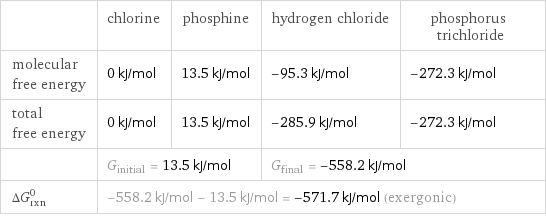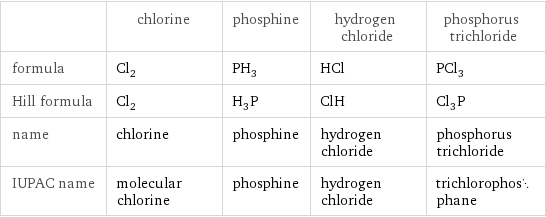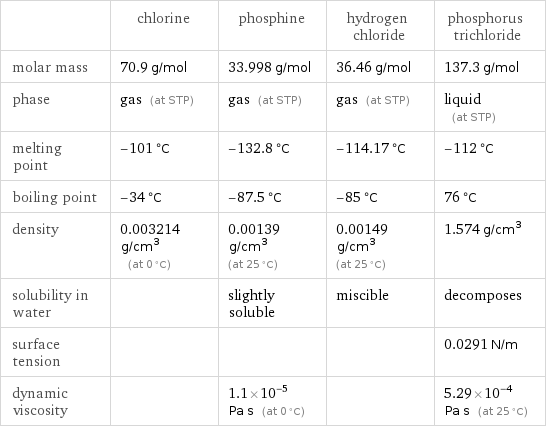Input interpretation

Cl_2 chlorine + PH_3 phosphine ⟶ HCl hydrogen chloride + PCl_3 phosphorus trichloride
Balanced equation

Balance the chemical equation algebraically: Cl_2 + PH_3 ⟶ HCl + PCl_3 Add stoichiometric coefficients, c_i, to the reactants and products: c_1 Cl_2 + c_2 PH_3 ⟶ c_3 HCl + c_4 PCl_3 Set the number of atoms in the reactants equal to the number of atoms in the products for Cl, H and P: Cl: | 2 c_1 = c_3 + 3 c_4 H: | 3 c_2 = c_3 P: | c_2 = c_4 Since the coefficients are relative quantities and underdetermined, choose a coefficient to set arbitrarily. To keep the coefficients small, the arbitrary value is ordinarily one. For instance, set c_2 = 1 and solve the system of equations for the remaining coefficients: c_1 = 3 c_2 = 1 c_3 = 3 c_4 = 1 Substitute the coefficients into the chemical reaction to obtain the balanced equation: Answer: | | 3 Cl_2 + PH_3 ⟶ 3 HCl + PCl_3
Structures

+ ⟶ +
Names

chlorine + phosphine ⟶ hydrogen chloride + phosphorus trichloride
Reaction thermodynamics
Gibbs free energy

| chlorine | phosphine | hydrogen chloride | phosphorus trichloride molecular free energy | 0 kJ/mol | 13.5 kJ/mol | -95.3 kJ/mol | -272.3 kJ/mol total free energy | 0 kJ/mol | 13.5 kJ/mol | -285.9 kJ/mol | -272.3 kJ/mol | G_initial = 13.5 kJ/mol | | G_final = -558.2 kJ/mol | ΔG_rxn^0 | -558.2 kJ/mol - 13.5 kJ/mol = -571.7 kJ/mol (exergonic) | | |
Equilibrium constant
![Construct the equilibrium constant, K, expression for: Cl_2 + PH_3 ⟶ HCl + PCl_3 Plan: • Balance the chemical equation. • Determine the stoichiometric numbers. • Assemble the activity expression for each chemical species. • Use the activity expressions to build the equilibrium constant expression. Write the balanced chemical equation: 3 Cl_2 + PH_3 ⟶ 3 HCl + PCl_3 Assign stoichiometric numbers, ν_i, using the stoichiometric coefficients, c_i, from the balanced chemical equation in the following manner: ν_i = -c_i for reactants and ν_i = c_i for products: chemical species | c_i | ν_i Cl_2 | 3 | -3 PH_3 | 1 | -1 HCl | 3 | 3 PCl_3 | 1 | 1 Assemble the activity expressions accounting for the state of matter and ν_i: chemical species | c_i | ν_i | activity expression Cl_2 | 3 | -3 | ([Cl2])^(-3) PH_3 | 1 | -1 | ([PH3])^(-1) HCl | 3 | 3 | ([HCl])^3 PCl_3 | 1 | 1 | [PCl3] The equilibrium constant symbol in the concentration basis is: K_c Mulitply the activity expressions to arrive at the K_c expression: Answer: | | K_c = ([Cl2])^(-3) ([PH3])^(-1) ([HCl])^3 [PCl3] = (([HCl])^3 [PCl3])/(([Cl2])^3 [PH3])](../image_source/78493bebdc5cc091da319c1cd2b877cc.png)
Construct the equilibrium constant, K, expression for: Cl_2 + PH_3 ⟶ HCl + PCl_3 Plan: • Balance the chemical equation. • Determine the stoichiometric numbers. • Assemble the activity expression for each chemical species. • Use the activity expressions to build the equilibrium constant expression. Write the balanced chemical equation: 3 Cl_2 + PH_3 ⟶ 3 HCl + PCl_3 Assign stoichiometric numbers, ν_i, using the stoichiometric coefficients, c_i, from the balanced chemical equation in the following manner: ν_i = -c_i for reactants and ν_i = c_i for products: chemical species | c_i | ν_i Cl_2 | 3 | -3 PH_3 | 1 | -1 HCl | 3 | 3 PCl_3 | 1 | 1 Assemble the activity expressions accounting for the state of matter and ν_i: chemical species | c_i | ν_i | activity expression Cl_2 | 3 | -3 | ([Cl2])^(-3) PH_3 | 1 | -1 | ([PH3])^(-1) HCl | 3 | 3 | ([HCl])^3 PCl_3 | 1 | 1 | [PCl3] The equilibrium constant symbol in the concentration basis is: K_c Mulitply the activity expressions to arrive at the K_c expression: Answer: | | K_c = ([Cl2])^(-3) ([PH3])^(-1) ([HCl])^3 [PCl3] = (([HCl])^3 [PCl3])/(([Cl2])^3 [PH3])
Rate of reaction
![Construct the rate of reaction expression for: Cl_2 + PH_3 ⟶ HCl + PCl_3 Plan: • Balance the chemical equation. • Determine the stoichiometric numbers. • Assemble the rate term for each chemical species. • Write the rate of reaction expression. Write the balanced chemical equation: 3 Cl_2 + PH_3 ⟶ 3 HCl + PCl_3 Assign stoichiometric numbers, ν_i, using the stoichiometric coefficients, c_i, from the balanced chemical equation in the following manner: ν_i = -c_i for reactants and ν_i = c_i for products: chemical species | c_i | ν_i Cl_2 | 3 | -3 PH_3 | 1 | -1 HCl | 3 | 3 PCl_3 | 1 | 1 The rate term for each chemical species, B_i, is 1/ν_i(Δ[B_i])/(Δt) where [B_i] is the amount concentration and t is time: chemical species | c_i | ν_i | rate term Cl_2 | 3 | -3 | -1/3 (Δ[Cl2])/(Δt) PH_3 | 1 | -1 | -(Δ[PH3])/(Δt) HCl | 3 | 3 | 1/3 (Δ[HCl])/(Δt) PCl_3 | 1 | 1 | (Δ[PCl3])/(Δt) (for infinitesimal rate of change, replace Δ with d) Set the rate terms equal to each other to arrive at the rate expression: Answer: | | rate = -1/3 (Δ[Cl2])/(Δt) = -(Δ[PH3])/(Δt) = 1/3 (Δ[HCl])/(Δt) = (Δ[PCl3])/(Δt) (assuming constant volume and no accumulation of intermediates or side products)](../image_source/6a084c54de8789d5d58537da90941640.png)
Construct the rate of reaction expression for: Cl_2 + PH_3 ⟶ HCl + PCl_3 Plan: • Balance the chemical equation. • Determine the stoichiometric numbers. • Assemble the rate term for each chemical species. • Write the rate of reaction expression. Write the balanced chemical equation: 3 Cl_2 + PH_3 ⟶ 3 HCl + PCl_3 Assign stoichiometric numbers, ν_i, using the stoichiometric coefficients, c_i, from the balanced chemical equation in the following manner: ν_i = -c_i for reactants and ν_i = c_i for products: chemical species | c_i | ν_i Cl_2 | 3 | -3 PH_3 | 1 | -1 HCl | 3 | 3 PCl_3 | 1 | 1 The rate term for each chemical species, B_i, is 1/ν_i(Δ[B_i])/(Δt) where [B_i] is the amount concentration and t is time: chemical species | c_i | ν_i | rate term Cl_2 | 3 | -3 | -1/3 (Δ[Cl2])/(Δt) PH_3 | 1 | -1 | -(Δ[PH3])/(Δt) HCl | 3 | 3 | 1/3 (Δ[HCl])/(Δt) PCl_3 | 1 | 1 | (Δ[PCl3])/(Δt) (for infinitesimal rate of change, replace Δ with d) Set the rate terms equal to each other to arrive at the rate expression: Answer: | | rate = -1/3 (Δ[Cl2])/(Δt) = -(Δ[PH3])/(Δt) = 1/3 (Δ[HCl])/(Δt) = (Δ[PCl3])/(Δt) (assuming constant volume and no accumulation of intermediates or side products)
Chemical names and formulas

| chlorine | phosphine | hydrogen chloride | phosphorus trichloride formula | Cl_2 | PH_3 | HCl | PCl_3 Hill formula | Cl_2 | H_3P | ClH | Cl_3P name | chlorine | phosphine | hydrogen chloride | phosphorus trichloride IUPAC name | molecular chlorine | phosphine | hydrogen chloride | trichlorophosphane
Substance properties

| chlorine | phosphine | hydrogen chloride | phosphorus trichloride molar mass | 70.9 g/mol | 33.998 g/mol | 36.46 g/mol | 137.3 g/mol phase | gas (at STP) | gas (at STP) | gas (at STP) | liquid (at STP) melting point | -101 °C | -132.8 °C | -114.17 °C | -112 °C boiling point | -34 °C | -87.5 °C | -85 °C | 76 °C density | 0.003214 g/cm^3 (at 0 °C) | 0.00139 g/cm^3 (at 25 °C) | 0.00149 g/cm^3 (at 25 °C) | 1.574 g/cm^3 solubility in water | | slightly soluble | miscible | decomposes surface tension | | | | 0.0291 N/m dynamic viscosity | | 1.1×10^-5 Pa s (at 0 °C) | | 5.29×10^-4 Pa s (at 25 °C)
Units
